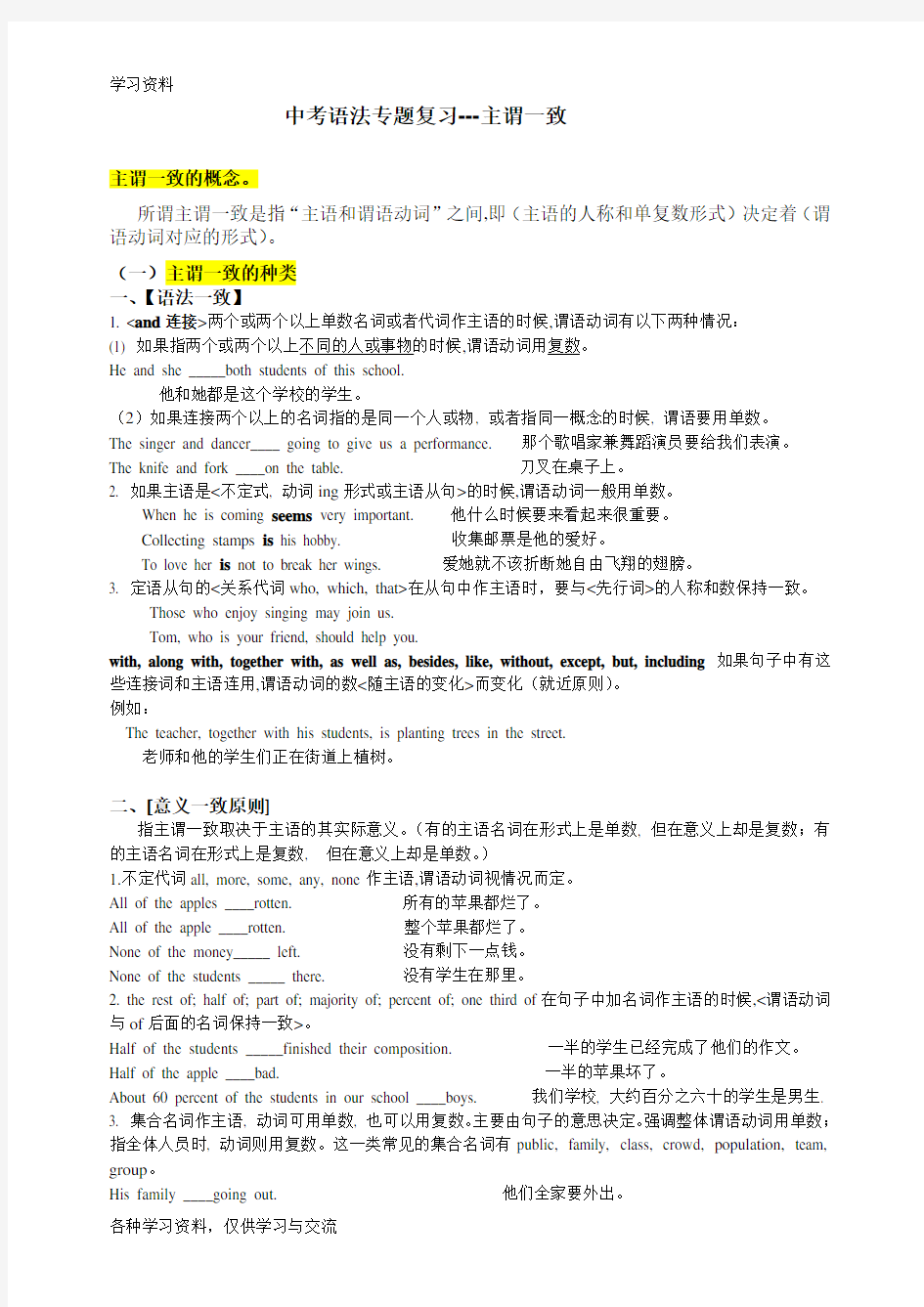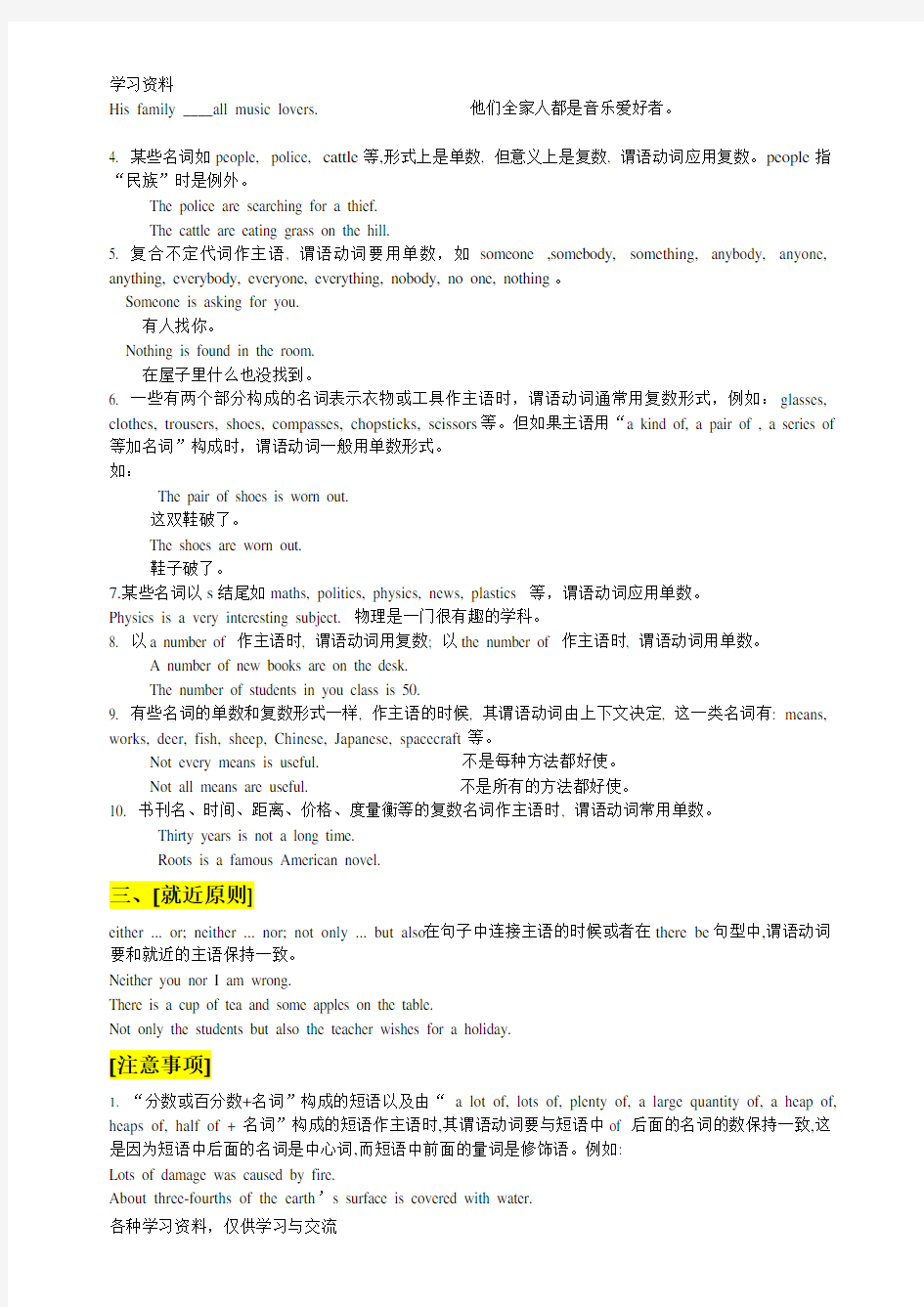

中考语法专题复习---主谓一致
主谓一致的概念。
所谓主谓一致是指“主语和谓语动词”之间,即(主语的人称和单复数形式)决定着(谓语动词对应的形式)。
(一)主谓一致的种类
一、【语法一致】
1.
(1) 如果指两个或两个以上不同的人或事物的时候,谓语动词用复数。
He and she _____both students of this school.
他和她都是这个学校的学生。
(2)如果连接两个以上的名词指的是同一个人或物, 或者指同一概念的时候, 谓语要用单数。
The singer and dancer____ going to give us a performance. 那个歌唱家兼舞蹈演员要给我们表演。
The knife and fork ____on the table. 刀叉在桌子上。
2. 如果主语是<不定式, 动词ing形式或主语从句>的时候,谓语动词一般用单数。
When he is coming seems very important. 他什么时候要来看起来很重要。
Collecting stamps is his hobby. 收集邮票是他的爱好。
To love her is not to break her wings. 爱她就不该折断她自由飞翔的翅膀。
3. 定语从句的<关系代词who, which, that>在从句中作主语时,要与<先行词>的人称和数保持一致。
Those who enjoy singing may join us.
Tom, who is your friend, should help you.
with, along with, together with, as well as, besides, like, without, except, but, including 如果句子中有这些连接词和主语连用,谓语动词的数<随主语的变化>而变化(就近原则)。
例如:
The teacher, together with his students, is planting trees in the street.
老师和他的学生们正在街道上植树。
二、[意义一致原则]
指主谓一致取决于主语的其实际意义。(有的主语名词在形式上是单数, 但在意义上却是复数;有的主语名词在形式上是复数, 但在意义上却是单数。)
1.不定代词all, more, some, any, none作主语,谓语动词视情况而定。
All of the apples ____rotten. 所有的苹果都烂了。
All of the apple ____rotten. 整个苹果都烂了。
None of the money_____ left. 没有剩下一点钱。
None of the students _____ there. 没有学生在那里。
2. the rest of; half of; part of; majority of; percent of; one third of在句子中加名词作主语的时候,<谓语动词与of后面的名词保持一致>。
Half of the students _____finished their composition. 一半的学生已经完成了他们的作文。Half of the apple ____bad. 一半的苹果坏了。
About 60 percent of the students in our school ____boys. 我们学校, 大约百分之六十的学生是男生.
3. 集合名词作主语, 动词可用单数, 也可以用复数。主要由句子的意思决定。强调整体谓语动词用单数;指全体人员时, 动词则用复数。这一类常见的集合名词有public, family, class, crowd, population, team, group。
His family ____going out. 他们全家要外出。
His family ____all music lovers. 他们全家人都是音乐爱好者。
4. 某些名词如people, police, cattle等,形式上是单数, 但意义上是复数, 谓语动词应用复数。people指“民族”时是例外。
The police are searching for a thief.
The cattle are eating grass on the hill.
5. 复合不定代词作主语, 谓语动词要用单数,如someone ,somebody, something, anybody, anyone, anything, everybody, everyone, everything, nobody, no one, nothing。
Someone is asking for you.
有人找你。
Nothing is found in the room.
在屋子里什么也没找到。
6. 一些有两个部分构成的名词表示衣物或工具作主语时,谓语动词通常用复数形式,例如:glasses, clothes, trousers, shoes, compasses, chopsticks, scissors等。但如果主语用“a kind of, a pair of , a series of 等加名词”构成时,谓语动词一般用单数形式。
如:
The pair of shoes is worn out.
这双鞋破了。
The shoes are worn out.
鞋子破了。
7.某些名词以s结尾如maths, politics, physics, news, plastics 等,谓语动词应用单数。
Physics is a very interesting subject. 物理是一门很有趣的学科。
8. 以a number of 作主语时, 谓语动词用复数; 以the number of 作主语时, 谓语动词用单数。
A number of new books are on the desk.
The number of students in you class is 50.
9. 有些名词的单数和复数形式一样, 作主语的时候, 其谓语动词由上下文决定, 这一类名词有: means, works, deer, fish, sheep, Chinese, Japanese, spacecraft等。
Not every means is useful. 不是每种方法都好使。
Not all means are useful. 不是所有的方法都好使。
10. 书刊名、时间、距离、价格、度量衡等的复数名词作主语时, 谓语动词常用单数。
Thirty years is not a long time.
Roots is a famous American novel.
三、[就近原则]
either ... or; neither ... nor; not only ... but also在句子中连接主语的时候或者在there be句型中,谓语动词要和就近的主语保持一致。
Neither you nor I am wrong.
There is a cup of tea and some apples on the table.
Not only the students but also the teacher wishes for a holiday.
[注意事项]
1. “分数或百分数+名词”构成的短语以及由“a lot of, lots of, plenty of, a large quantity of, a heap of, heaps of, half of + 名词”构成的短语作主语时,其谓语动词要与短语中of 后面的名词的数保持一致,这是因为短语中后面的名词是中心词,而短语中前面的量词是修饰语。例如:
Lots of damage was caused by fire.
About three-fourths of the earth’s surface is covered with water.